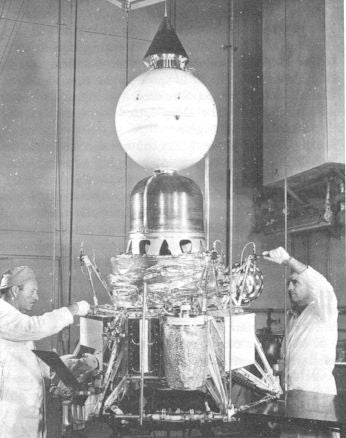This article was published in Scientific American’s former blog network and reflects the views of the author, not necessarily those of Scientific American
If I tell you that two wooden spheres have been orbiting the Sun since 1962 you might wonder if I'm not long overdue for a vacation.
But, as far as we know this is entirely true. And the story of the first wooden spacecraft is full of ambitious rocketry, failure, and inventive engineering.
In 1961, about a year before President Kennedy's famous Moon speech, NASA was ramping up its efforts to get beyond Earth orbit and to begin probing the lunar surface. Already in 1959 the Soviets had managed to drop the first impactor onto the Moon (the Luna 2 probe), and NASA needed to get data from closer to the Moon than possible with relatively distant flybys.
On supporting science journalism
If you're enjoying this article, consider supporting our award-winning journalism by subscribing. By purchasing a subscription you are helping to ensure the future of impactful stories about the discoveries and ideas shaping our world today.
The Ranger program, run by the Jet Propulsion Lab, was aiming to get the first up-close images of the Moon. It was also integrated with the testing of the new Atlas-Agena launch system, essentially a modified missile launching architecture.
The first two Ranger probes, 1 and 2, didn't do so well, suffering various failures and not getting any further than very low Earth orbit. But Ranger's 3, 4, and 5 were much more ambitious and, to the best of my knowledge, resulted in the first wooden structures being placed into interplanetary space.
A key part of each of these three Rangers was a science payload designed to survive moderately rough impact on the lunar surface and send back seismological data. In order to get the sensing instrument onto the Moon it was packed inside a 65 centimeter diameter sphere of balsawood. The plan was that this 'impact-limiter' would absorb most of the shock of impact, bounce around a few times, and then come to rest.
Someone was sufficiently proud of the idea that the photo below was taken in 1960 during the mission design process.
.jpg?w=700)
The wooden sphere held by Systems Design secretary Pat McKibben. Credit: NASA, JPL
But the ingenuity didn't stop there. That hollow core was filled with fluid, and once the sphere settled on the lunar surface, the instrument package - floating inside - would right itself, the fluid would be drained, and you'd have your science experiment right-side up on the Moon.
Unfortunately things didn't go quite as planned during the three Ranger missions that carried these wooden impactor probes. Ranger 3 missed the Moon by about 36,000 kilometers, and sailed off onto a sun-centric orbit. Ranger 4 fared only slightly better (in terms of its design goals), and did indeed end up crashing onto the Moon. But it crashed with its main transmitters offline, and on the lunar farside, where the feeble 50 milliwatt transmitter in the wooden sphere was as good as silenced.
That farside crash was still spun into good news by NASA's PR people - it was indeed the first US 'landing' on the Moon, and it was on the uncharted farside. Take that Soviet Union!
Ranger 5 was also ill-fated. An electrical short from its solar panels meant that its batteries wouldn't charge, and controllers were unable to make the needed mid-course trajectory alterations to get to the Moon. Instead the spacecraft whizzed past the lunar surface, missing it by a mere 700 or so kilometers and scooting into another heliocentric (sun-centric) orbit.
Later Ranger spacecraft were rather more successful, but none carried the balsawood-encased seismometers.
So what this all means is that, as far as we know, there are still two 65 centimeter wooden balls orbiting the Sun.
I can't help but speculate that if some alien species ever comes looking, and they find one of the Ranger probes, they might be impressed by a species that apparently was so sophisticated that it combined organic materials, produced by a living thing, with inorganic, machine parts.

Ranger 3 being prepped for launch, balsawood ball on top. Credit: NASA